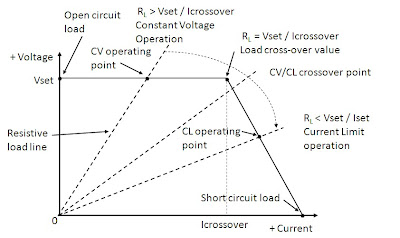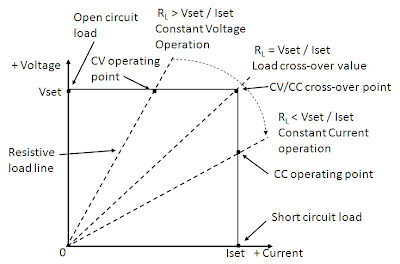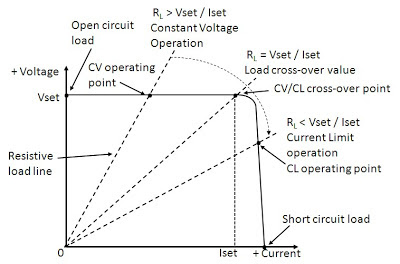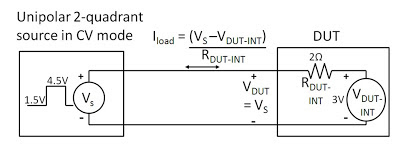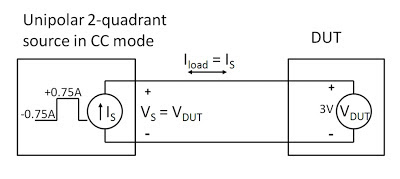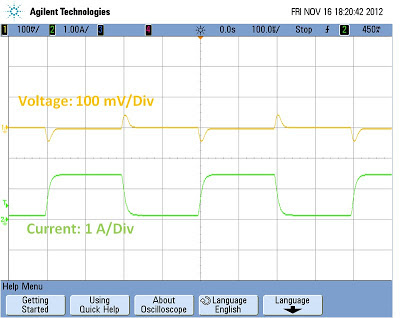On a previous posting
“The difference between constant
current and current limit in DC power supplies”, I discussed what
differentiates a DC power supply having a constant current operation in
comparison to having strictly a current limit for over-current protection. In
that post I had depicted one very conventional current limit behavior. However
there is actually quite a variety of current limits incorporated in different
DC power supplies, depending on the intended end-use of the power supply.
Fold-back Current
Limit
The output characteristic of a constant voltage (CV)
power supply utilizing fold-back current limiting is depicted in Figure 1.
Fold-back current limiting is sometimes used to provide a higher level of
protection for DUTs where excess current and power dissipation can cause damage
to a DUT that has gone into an overload condition. This is accomplished by
reducing both the current and voltage as the DUT goes further into overload.
The short circuit current will typically be 20% to 50% of the maximum current
level. A reasonable margin between the crossover current point and required
maximum rated DUT current needs to be established in order to prevent false
over-current tripping conditions. Due to the fold-back nature, and depending on
the loading nature of the DUT, the operating point could drop down towards the
short-circuit operating point once the crossover point is reached/exceeded.
This would require powering the DUT down and up again in order to get back to
the CV operating region.

Figure 1: Output characteristic of a CV power supply with
fold-back current limiting
In addition to providing over-current protection for the
DUT, fold-back current limiting is often employed in fixed output linear DC
power supplies as a means for reducing worst case dissipation in the power
supply itself. Under short circuit conditions the voltage normally appearing
across the DUT instead appears across the power supply’s internal series linear
regulator, requiring it to dissipate considerably more power than it has to
under normal operating conditions. By employing fold-back current limiting the
power dissipation on the series-linear regulator is greatly reduced under
overload conditions, reducing the size and cost of the series-linear regulator
for a given output power rating of the DC linear power supply.
Fold-forward
Current Limit
A variety of loading devices, such as electric motors,
DC-DC converters, and large capacitive loads can draw large peak currents at
startup. Because of this they can often be better suited for being powered by a
DC power supply that has a fold-forward current limit characteristic, as
depicted in Figure 2. With fold-forward current limiting after exceeding the
crossover current limit the current level instead continues to increase while
the voltage drops while the loading increases.
Figure 2: Output characteristic of a CV power supply with
fold-forward current limiting
As one example of where fold-forward current limiting is
a benefit, it can help a motor start under load which otherwise would not start
under other current-limits. Indeed, with fold-back current limiting, a motor
may not and then it would remain stalled, due to the reduced current.
Special Purpose
Current Limits
Unlike the previous current limit schemes which are widely
standard practice, there is a number of other current limit circuits used,
often tailored for more application-specific purposes. One example of this is
the current limiting employed in our 66300 series DC sources for powering
mobile phones and other battery powered mobile wireless devices. Its output
characteristic is depicted in Figure 3.
Figure 3: Agilent 66300 Series DC source output
characteristics
We refer to this power supply series as battery emulator
DC sources. One reason why is they are 2-quadrant DC sources. Like a rechargeable battery, they need to be
able to source current when powering the mobile device and then sink current
when the mobile device is in its charging mode.
In Figure 3 there are actually two separate current limits; one for
sourcing current and another for sinking current. Each has different and
distinctive characteristics for specific purposes.
Many battery powered mobile wireless devices draw power
and current in short, high peak bursts, especially when transmitting. To better
accommodate these short, high peaks, the 66300 series DC sources have a
time-limited peak current limit that is of sufficient duration to support these
high peaks. They also have a programmable constant current level that will
over-ride the peak current limit when the average current value of the pulsed
current drain reaches this programmed level. With this approach a higher peak
power mobile device can be powered from a smaller DC power source.
Just like an electronic load, when the 66300 series DC
source is sinking current the limiting factor is how much power it is able to
dissipate. Instead of using a fixed current limit, it uses a fold-forward
characteristic current limit (although folding forward in the negative
direction!). This is not done for reasons that a fold-forward current limit that
was just discussed is used; it is done so higher charging currents at lower
voltage levels can be accommodated, taking advantage of the available power
that can be dissipated. Again, this provides the user with greater capability
in comparison to using a fixed-value limit.
Other types of current limits exist for other specific
reasons so it is helpful to be aware that not all current limits are the same
when selecting a DC power supply for a particular application!
Reference: Agilent Technologies DC Power Supply Handbook,
application note AN-90B, part number 5952-4020
“Click here to access”



